Oberlin students come from all around the United States and the
world. This diversity is part of what makes Oberlin
special.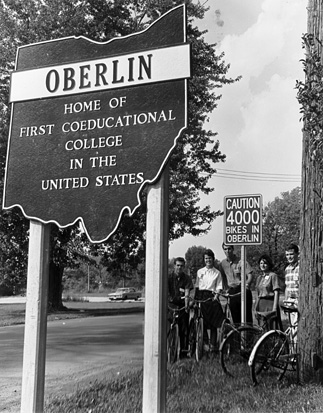
When Oberlin College admitted as students both men and women, it became the first coeducational college in the United States. The open-admissions policy "irrespective of color" proclaimed in 1835 meant that Oberlin College would also have black and white students studying together. Oberlin College was unique in its willingness to educate men and women, blacks and whites.
Today Oberlin College still accepts students without any restriction by gender, race, or religion. Living and studying with people from different backgrounds provides valuable learning experiences .
Oberlin College provides an outstanding education and its students have made outstanding contributions to the world. For example, three Oberlin College graduates have won the world-famous Nobel Prize. These are awards that are given out one a year in a worldwide competition to people who have done outstanding work in the fields of medicine, chemistry, physics, economics, literature, and the promotion of world peace. The Nobel Prize is named after a Swedish chemist, Alfred Nobel, who invented dynamite. When he died in 1896, Mr. Nobel's will set up the Nobel Prize.
In 1923, Robert Millikan, class of 1891, was the first Oberlin graduate to win the Nobel Prize. He won the physics honor for his work that helps us understand about electrical charges and photoelectric effects. In 1982, he had a U. S. postage stamp issued in his memory.
The second Oberlin College graduate to win a Nobel Prize was Roger Sperry, class of 1935. In 1981, Mr. Sperry won the award in medicine for his research on what the left and the right hemispheres of the human brain do.
In 1986, Oberlin College graduate Stanley Cohen, class of 1945, shared the Nobel Prize in medicine. The honor was for the discovery and description of the proteins that help the growth and proper functioning of the cells in the human body.
Many other Oberlin College students have made the world a better place in the fields that they followed after graduation. Oberlin College alumni are leaders in many fields.
What else makes Oberlin College special? Many students want to use their Oberlin education to improve the world by doing service projects. This is not a new thing for Oberlin students. Years ago Oberlin graduates who wanted to serve the world became Missionaries. Missionaries are people who travel to different parts of the world to organize churches, establish schools, provide medical assistance, and relieve famine.
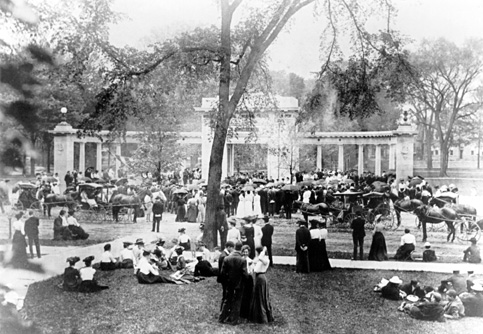 In
1900 a group of thirteen missionaries, most of whom were Oberlin
graduates, and five of their children were killed during a war in
China named the Boxer Rebellion. The Boxers were a group of Chinese
people who rose up against foreigners and native Christians in
northern China. The Memorial Arch on Tappan Square, dedicated in
1903, was built to honor the missionaries and their families that
died. Many Oberlin students in recent years felt that the arch should
be a memorial for everyone who died in the Boxer Rebellion and a
plaque was added in 1994 in memory of the Chinese who were killed in
that war.
In
1900 a group of thirteen missionaries, most of whom were Oberlin
graduates, and five of their children were killed during a war in
China named the Boxer Rebellion. The Boxers were a group of Chinese
people who rose up against foreigners and native Christians in
northern China. The Memorial Arch on Tappan Square, dedicated in
1903, was built to honor the missionaries and their families that
died. Many Oberlin students in recent years felt that the arch should
be a memorial for everyone who died in the Boxer Rebellion and a
plaque was added in 1994 in memory of the Chinese who were killed in
that war.
From the 1900s to the 1960s many Oberlin students did service locally through the YMCA and the YWCA. Students would help teach English to new immigrants, work at clothing and food distribution sites, and visit children in juvenile homes. In 1964 Oberlin students helped rebuild Antioch Missionary Baptist Church in Ripley, Mississippi after it was burned down by a group of people known as the KKK who were against the civil rights movement. Oberlin students helped to register voters in the 60s and still help today. After the race riots in south central Los Angeles in 1992 many students went to help rebuild homes and businesses. Funds from the college and the Oberlin community helped pay for travel expenses, housing, and food.
In 1994 President Nancy Dye established an office called the Center for Service and Learning to help organize and encourage community service at Oberlin College. It helps get students, faculty, and staff of the college involved in local and national service efforts. The Center connects those in need of volunteers with students interested in volunteering. Oberlin College still teaches its students the importance of learning and labor.
Learn about the history of the Young Men's Christian Association -- YMCA.
Read about civil and human rights:
There are two more things that make Oberlin College different from other colleges. The Experimental College and Winter Term offer Oberlin students learning opportunities beyond those that the faculty can provide.
The Experimental College (ExCo) is a division of the college that allows any student, faculty or staff member, or townsperson to teach a college course that is not offered in the normal college class listings. Anyone can sign up for an ExCo course for the spring or fall semester. In the past there have been courses about the Beatles, Dr. Suess, and even Synchronized Swimming. What kind of course would you like to take?
Winter Term takes place in the month of January when regular weekly classes are suspended so that Oberlin College students can work on a personal project. It is a chance to do service projects in the community or internships in areas of interest. Winter Term helps make Oberlin College unique because very few colleges offer students the chance to pursue a personal project and receive academic credit for it. Many students work in the Oberlin Schools for their Winter Term projects. Have you seen any of them?
Oberlin College is one of the largest industries in Lorain County. It costs millions of dollars to operate the college each year. This money is needed for the salaries of professors and staff, the housing and feeding of the students, and the maintenance of the buildings and grounds
Where does the money come from? About half comes from student tuition and fees, the money the students and their families pay to the college. Another portion comes from gifts that people give to improve the college. Some of this money is spent right away on normal operating expenses. Some of the money is saved and invested. Usually only the interest from the investment is spent. This reserved money is Oberlin's Endowment and it provides a portion of each year's expenses.
Most people who give endowments are Oberlin College alumni, people who attended or graduated from Oberlin College. One of the largest gifts ever given was the $12,000,000 given by Charles Martin Hall, the Oberlin student and inventor whose very successful company, called ALCOA, used the process he discovered to make aluminum products.
Oberlin College has about 2,800 students. About 300 of these students are in the Oberlin Music Conservatory. This means that they are concentrating on a particular musical skill such as playing an instrument or composing music. Some students are "Double-Degree" students. This means that they are studying in both the College and the Music Conservatory. There are over 300 professors in both the College of Arts and Sciences and the Conservatory of Music. Besides the professors there are about five hundred other people working full-time and many more working part-time keeping the buildings in good repair, working in offices, making meals for the dining halls, or keeping the college grounds looking nice year round.
More than 64 buildings belong to the college. These buildings contain many different kinds of spaces such as classrooms, performance halls, libraries, offices, dormitory rooms, dining halls, and places to relax and exercise.
Some of these buildings are almost new. Stevenson Dining Hall was built in 1991. Some of the buildings are old but have been renovated. For example, Peters Hall has been redesigned on the inside, but the outside structure is the same. Other college buildings are old all over. A dormitory called "Allencroft," on the corner of Professor and Forest Street, was built in 1861 during the Civil War. What college buildings would you want to visit?
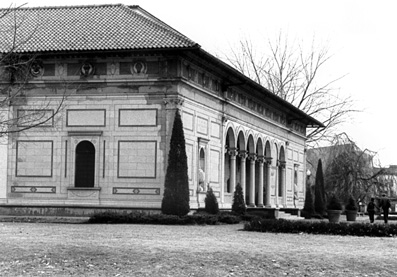 The
Allen Art Museum houses art of all kinds including African, American,
Ancient, Asian, European and Modern Art. The collection of art pieces
totals 14,000 objects. These objects are displayed on a rotation so
that the museum is always changing what is on display. One of the
special things about the Allen Art Museum is its "Art Rental" program
that allows students and townspeople to rent works of art for a
semester at a time for a small fee. There are 300 original works in
the Art Rental program collection including works by Picasso,
Matisse, and Chagall. Would you like to have a real Picasso in your
house?
The
Allen Art Museum houses art of all kinds including African, American,
Ancient, Asian, European and Modern Art. The collection of art pieces
totals 14,000 objects. These objects are displayed on a rotation so
that the museum is always changing what is on display. One of the
special things about the Allen Art Museum is its "Art Rental" program
that allows students and townspeople to rent works of art for a
semester at a time for a small fee. There are 300 original works in
the Art Rental program collection including works by Picasso,
Matisse, and Chagall. Would you like to have a real Picasso in your
house?
The Conservatory of Music houses two concert halls, 153 practice
rooms, and more Steinway Pianos than any place in the world except
the Steinway factory. With student, faculty, and visiting performers,
the Conservatory presents at least 400 concerts every year. One thing
that makes the Conservatory special is the TIMARA (tih-mah'-rah)
department. TIMARA stands for Technology In Music And Related Arts.
It is a Conservatory Department that uses computers and other
technology to combine music with other arts like dance, theater,
video and film. Oberlin was the first to bring music technology to a
small undergraduate institution. It is one way the Conservatory is
looking into the future of Music.
The Warner Center houses the Theater and Dance departments. The building was built as a men's gymnasium, but has since been converted to space for the Theater and Dance Department. Warner has seven studios that can be used for classes, rehearsals and performances. Warner Main Space is used for many dance performances each semester.
Finney Chapel and Hall Auditorium hold many special concerts, operas, dances, and theater performances each year. Over 1500 people can be seated in the audience at Finney Chapel and over 150 more on the stage. Hall Auditorium seats over 500 and its annex houses classrooms, offices, and a smaller theater named "Little Theater."
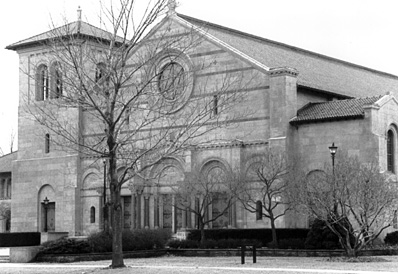
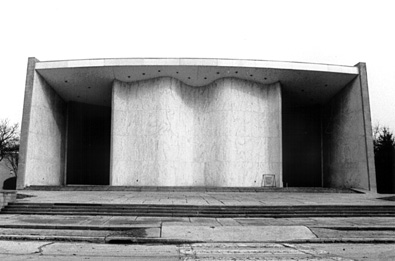
Hales Gymnasium and Phillips Physical Education Center house the college's athletic activities. Hales was opened in 1939 as a women's gym with a locker room, a large main gym, and a swimming pool. Its annex, built in 1963, houses the six alley College Lanes, the Cat in the Cream coffee house, and the Billiard Room. Phillips Physical Education Center was built in 1971. It is the heart of physical fitness at Oberlin College with indoor spaces for handball, squash, and racquetball, volleyball and basketball, swimming and diving, weight-training, and even table tennis. The most recent addition to Phillips is the Heisman Field House which opened in 1992 with an indoor track and indoor tennis courts.
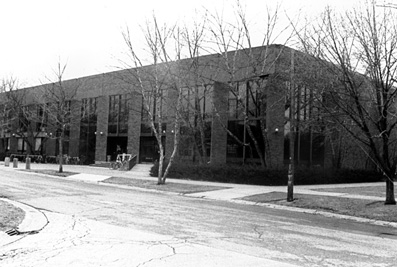
Although the main purpose of Oberlin College is to educate its students, the College also enriches the lives of the families living here. Oberlin is a small town with the resources of a big city, thanks to Oberlin College.
Draw your favorite college building (inside, outside, or both)..
Use words to explain what you like about it.
Oberlin: Yesterday, Today, Tomorrow Home
Page | Table of Contents | ![]()
![]()